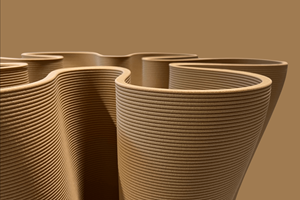Airbus Helicopters verify performance of 410km/h Clean Sky 2 demonstrator
X3-based, compound VTOL airframe configuration nears final design but exact use of composites yet to be detailed
Airbus Helicopters, Marignane, France, has achieved an important milestone in the development of the high-speed, compound helicopter demonstrator currently being built as part of the LifeRCraft Compound Rotorcraft Clean Sky 2 European research program. A mockup of the vertical takeoff and landing (VTOL) airframe design has now undergone windtunnel testing in an Airbus facility. The tests proved the viability of the chosen design’s efficiency, sustainability and performance, paving the way for a preliminary design review at the end of 2016. The overall project, meanwhile, has passed its first official milestone by reaching the end of its pre-design phase.
Building upon the achievements of Airbus Helicopters’ record-breaking X3 technology demonstrator, the Clean Sky-demonstrator will help refine the “compound” configuration and bring it closer to an operational design, aimed to meet future requirements for increased speed and better cost-efficiency, plus dramatic reductions in emissions and acoustic footprint. Flight-testing of the prototype is expected to start in 2019.
According to a stakeholder presentation in March 2015, development of the Clean Sky technology demonstrator is split between various Airbus Helicopters sites, with Donauwörth, Germany in charge of the main fuselage and wings, the Le Bourget, France blade facility handling main and lateral rotors, and the tail boom and its control surfaces prepared by its factory in Albacete, Spain. Overall project management, integration and ground- and flight-test activities will be carried out at the company’s headquarters. This same source indicated the fuselage should be made from advanced composites or a metallic/composite hybrid, with research contributed by Romania’s INCAS aerospace research agency (Bucharest).
According to a 2014 Airbus Helicopters presentation on the Clean Sky 2 LifeRCraft Compound Rotorcraft program, Airbus Helicopters has led the work package for design and manufacturing of an advanced wing structure for rotorcraft additional lift. That program also features a work package titled: Wing and Tail Unit Components Multifunctional Design and Manufacturing (including Out of Autoclave composites). LifeRCraft Compound Rotorcraft Airframe development was scheduled to start in Jan. 2015 and be completed in 5.5 years with critical design review at the end of 2016.
Airbus Helicopters has used composites in its rotorcraft for decades (see “Donauwörth as composites pioneer”), and reports it has tested natural flax fibers in hybrid composite materials on the X3 as part of environment and product life cycle improvements. With its partners, it is also assessing and developing solutions for recycling materials used to build current and future helicopters.
“We are honored to be carrying out this project on behalf of the Clean Sky Joint Undertaking and the large number of European companies who are taking part in the development. Our ambition is to become the benchmark of the rotorcraft industry, and as such we are willing to drive a bold vision for the future of helicopter transportation, said Jean-Brice Dumont, Airbus Helicopters Chief Technical Officer. “Our Clean Sky 2-demonstrator will not only be about going faster; it will help make speed smarter by seeking the best trade-off between cost-efficiency, sustainability and mission performance. We want to break the cost barrier usually associated with increased speed and range and pave the way for new missions for 2030 and beyond, by providing crucial emergency or door-to-door transportation services to European citizens where they need it most.”
Ron Van Manen, Clean Sky 2 Program Manager, highlighted that “The LifeRCraft Demonstrator project in Clean Sky 2 will pull together capabilities from across the European Research Area, addressing technology gaps in systems, structures and overall design and demonstrating the viability of a compound rotorcraft design . . . that will strengthen Europe’s already formidable competitive position in the vertical lift aviation sector."
For more on the US-based Future Vertical Lift program, see “Composites help Bell V-280 toward Future Vertical Lift” and “Sikorsky S97 RAIDER helicopter completes first test flight”.
Related Content
Sulapac introduces Sulapac Flow 1.7 to replace PLA, ABS and PP in FDM, FGF
Available as filament and granules for extrusion, new wood composite matches properties yet is compostable, eliminates microplastics and reduces carbon footprint.
Read MoreOtto Aviation launches Phantom 3500 business jet with all-composite airframe from Leonardo
Promising 60% less fuel burn and 90% less emissions using SAF, the super-laminar flow design with windowless fuselage will be built using RTM in Florida facility with certification slated for 2030.
Read MoreCarbon fiber, bionic design achieve peak performance in race-ready production vehicle
Porsche worked with Action Composites to design and manufacture an innovative carbon fiber safety cage option to lightweight one of its series race vehicles, built in a one-shot compression molding process.
Read MorePlant tour: Airbus, Illescas, Spain
Airbus’ Illescas facility, featuring highly automated composites processes for the A350 lower wing cover and one-piece Section 19 fuselage barrels, works toward production ramp-ups and next-generation aircraft.
Read MoreRead Next
Scaling up, optimizing the flax fiber composite camper
Greenlander’s Sherpa RV cab, which is largely constructed from flax fiber/bio-epoxy sandwich panels, nears commercial production readiness and next-generation scale-up.
Read MoreNext-gen fan blades: Hybrid twin RTM, printed sensors, laser shock disassembly
MORPHO project demonstrates blade with 20% faster RTM cure cycle, uses AI-based monitoring for improved maintenance/life cycle management and proves laser shock disassembly for recycling.
Read MoreCeramic matrix composites: Faster, cheaper, higher temperature
New players proliferate, increasing CMC materials and manufacturing capacity, novel processes and automation to meet demand for higher part volumes and performance.
Read More












